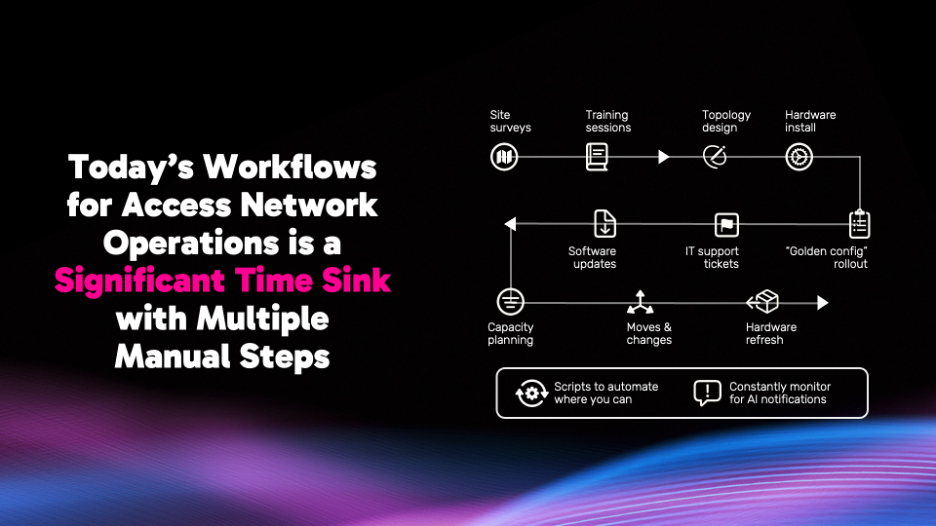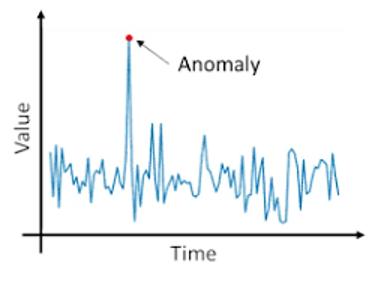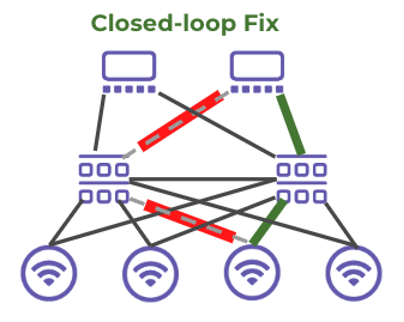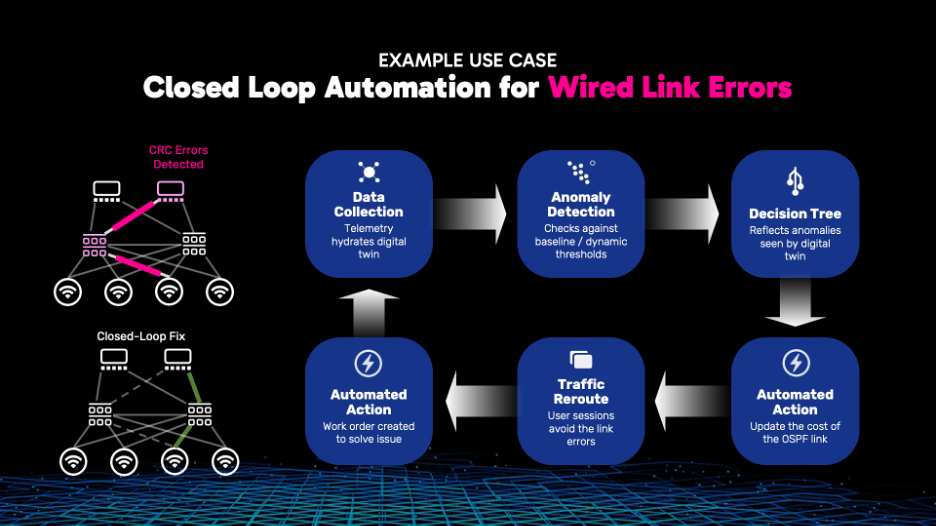Share Via
Introduction
I’ve watched enterprise network designers sift through various permutations of hardware and software from different vendors before arriving at the combination with the right config. No one dares touch that config because it is “golden” and changes to a “golden config” require multiple levels of approval.
Because of the sheer complexity of the network, IT relies on multiple eyes to look at the “golden config” ensuring that any change does not adversely affect the network. Figure 1. outlines the many manual steps it takes to get to the golden config and in most cases, maintain what they’ve built.

Fig 1: Today’s Legacy Access Network Operations
When unexpected network incidents occur, IT administrators are often forced to alter their golden config to address those incidents. This reactive approach leads to high mean time to resolution (MTTR) and a bad user experience. Any attempt to automate the response through scripts leads to additional overhead such as managing script accessibility and maintaining their compatibility with different software versions. In the end, IT administrators are bombarded with alerts and reports and left with no reliable tools to address them.
Nile’s Closed Loop Automation Approach
Nile is using AI and closed loop automation in network operations to completely automate the monitoring of network incidents and their resolution. IT administrators do not maintain any “golden configs”, write scripts or stare at various dashboards. If you would like to catch the demo before we dive deeper, here it is:
This closed loop approach is made possible by building AI and automation into the Nile Access Service, which is purpose built for cloud-based orchestration.
Our Nile Services Cloud is an important aspect as it continuously analyzes time series data from Nile network elements. We continually look for anomalies and take corrective actions – all in a completely automated manner.
A Unique Digital Twin
The Nile Services Cloud includes a Digital Twin of the network in the real-world after the successful completion of the installation process. Smart Agents built into the Nile Services Cloud collect telemetry data from both an “outside-in” and “inside-out” perspective.
Smart Agents for Outside-In Perspective
Physical and virtual sensors provide the outside-in perspective of the Nile Service Blocks. Physical sensors are strategically placed at the service perimeters and virtual sensors are software that leverage dedicated radio modules built into Nile access points. Both physical and virtual sensors probe for environmental changes and send the collected data to the Nile Services Cloud.
Smart Agents for Inside-Out Perspective
Smart Agents within the Nile Services Cloud analyze network data on system resources, hardware accessories and connections with client devices at larget scale. The following is a list of some of the data sources from Nile access points and switches:
- System Resource Data: Statistics on CPU, memory, protocol, interface, etc.
- Hardware Data: Statistics on power fluctuations, cabling disconnects, etc.
- Client Connectivity Data: User/device associations, connection metrics, etc.
Cognitive Decisions Detect Anomalies
The models in our Cognitive Decision capabilities within the Nile Services Cloud look for anomalies in the collected data. The models process historical data and predict the metric values, such as a threshold for a future time period that takes into consideration influencing contextual factors. Factors can include items such as:
- Seasonality
- Rate of change
- Environment conditions,
- Changes in client devices and their behavior

Fig 2: Anomaly Detection
In the example shown below, models in Cognitive Decisions detected an unusual spike in CRC errors in one of the outgoing links of a distribution switch. If this condition is left unaddressed the traffic will be blackholed until a manual intervention fixes the problem.

Fig 3: Cognitive Decisions Update Digital Twin with CRC Errors
Cognitive Decisions Take Remedial Action
As a result, the Digital Twin reflects that the link with CRC errors is faulty. This update is made visible across all of the Nile AI applications. It also downgrades the cost associated with the routing protocol of the faulty links. Post the convergence of routing calculations, the routing protocol updates the routes to steer the traffic around the anomalous link.

Fig 4: Cognitive Decisions Takes Remedial Actions – Rerouting the Traffic
Cognitive Decisions Alerts Customers
The Cognitive Decisions module within the Nile Services Cloud alerts the customer about the anomaly with the following information:
- Condition
- Link Details
- Network element details
- Detected anomaly
- Remedy
- Immediate remedial action taken (i.e., traffic rerouted around the anomalous link)
Cognitive Decisions Request for Long Term Fix
The Cognitive Decisions module marks the link as “deviation” as it is not adhering to the Nile standard. Actions automatically inform the following stakeholders:
- Customer IT administrators,
- Customer Success Managers (CSM),
- Customer Support Engineers, and
- Nile’s Production Network Engineers (PNEs)
A work order is also automatically created to address replacing the faulty cable that’s resulting in the proactively detected CRC errors.
Addressing Deviations in the Digital Twin
Upon successful completion of the work order by replacing the faulty cable, Smart Agents analyze the data one more time and update the Digital Twin within the Nile Services Cloud – ensuring that it adheres to Nile’s standards measured against performance guarantees.
Conclusion
In today’s faced paced world, minutes saved can amount to thousands of dollars and hours saved. The Nile Access Service is purpose built to leverage AI and cloud based automation to help IT organizations address network issues before they become big problems.
Nile Services Cloud is unique in its ability to automatically maintain and measure real-time performance against the Digital Twin of a Nile network. Smart Agents within the Nile Services Cloud provide both inside out and an outside in view, Cognitive Decisions analyze the changes in real time and take remedial action to automatically address any network incidents.

This closed loop approach to network operations completely eliminates the manual monitoring of network incidents and responding to them, thus leading to lowered MTTR and a better IT and user experience. With automatically crafted and tracked work orders to address any incidents that require long term fixes, this full scale automation is a win-win for IT teams who want to reduce their operational burden for their wired and wireless LAN infrastructure: no more alert storms or staring at various dashboards looking for the needle in a haystack.


